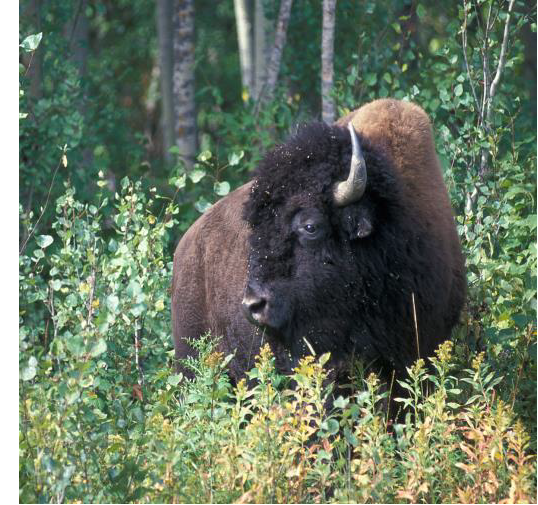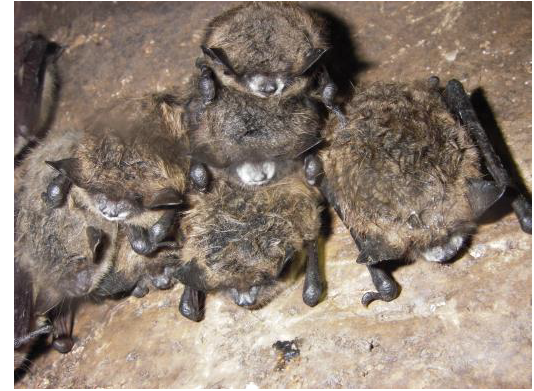Twenty-eight Canadian wildlife species were assessed as at risk at the recent COSEWIC (Committee on the Status of Endangered Wildlife in Canada) meeting held November 24th-29th, in Ottawa. Some species assessed at this meeting are showing signs of recovery as a result of actions taken since their previous assessment, but additional species are dwindling, and need our help more than ever. These assessments bring the total number of wildlife species recognized by COSEWIC as at risk to 686.
Canada’s biodiversity crisis

As demands for space and resources increase, so do direct and indirect impacts of human activities that push species towards extinction. Canada’s Species at Risk Act is designed to help restore these species. But as the number of species assessed as at risk climbs, is there hope that some of these species will someday return to healthy numbers?
A shadow of former abundance, but hope for the future
As recently as 150 years ago, millions of bison roamed across much of North America, and Short-tailed Albatrosses were common along Canada’s Pacific coast. Despite such abundances and their importance to our heritage, massive overhunting depleted these species. The Plains Bison was extirpated from Canada, the Wood Bison was reduced to fewer than 300 animals, and the Short-tailed Albatross, which breeds in the western Pacific, plunged to fewer than 40 breeding birds globally. Nearly a century after conservation efforts began, there are now about 2,500 wild Plains Bison, 7,000-10,000 wild Wood Bison, and roughly 1,700 Short-tailed Albatrosses. While albatross numbers continue to increase, future expansion of both bison populations is limited by land use conflicts and concerns over the potential for transmission of diseases to livestock. Concerted conservation initiatives have brought both the bison and the albatross back from the brink, but persistent efforts will be required for sustained recovery.
Recovery takes time
Thanks to sustained international collaboration, the North Atlantic Right Whale is also showing signs of recovery. Like many whale species, this animal was hunted almost to extinction before receiving international protection in 1935. Canada and the United States have worked together to monitor and protect these whales, which migrate between their calving areas to the south, and their feeding areas in New England and Atlantic Canada. Re-routing of shipping lanes and modifications to fishing gear have reduced ship strikes and entanglement in nets, contributing to a doubling of the global population to almost 500 individuals. While this is good news, work will need to continue for many years to give this slowly reproducing animal time to rebuild its population to a safe level. At this meeting, COSEWIC confirmed the whale’s status as Endangered.
Two marine fishes demonstrate the challenges of protecting species off our shores. The Bocaccio from coastal British Columbia has declined by over 90% due to overfishing, and was assessed as Endangered. On the Atlantic coast, the White Hake has declined by 70-90%. Although fishing has been greatly reduced for both of these species for the past 10-15 years, neither is yet showing clear signs of recovery.

Three North American bat species plummeting
Three bat species assessed at this meeting remind us again that even the most abundant wildlife populations can plummet rapidly. In late 2011, wildlife officials in Nova Scotia asked COSEWIC to assess the Little Brown Myotis, Northern Myotis, and Tri-colored Bat. Alarming numbers of hibernating bats were dying from an introduced fungal disease known as White-nose Syndrome. This fungus flourishes in the caves and mines where these bats overwinter. Each of these three bats has experienced steep declines of up to 94% since the disease arrived in Canada in 2010, and millions of bats have died in northeastern North America. White-nose Syndrome first appeared in a cave in central New York in 2006, and has spread 200-250 km per year into 22 U.S. states, as well as Ontario, Quebec, Nova Scotia, New Brunswick, and Prince Edward Island. The disease is expected to spread across North America within two decades, and is likely to affect other species of hibernating bats. COSEWIC confirmed its emergency assessment of 2012, assessing all three bats as Endangered.
For these three bat species, the road to recovery will be long. The disease is still spreading, bat populations will continue to decline, and successful recovery is not guaranteed. We have learned from limited successes with other species that a coordinated approach that includes scientific research, effective conservation management, public awareness and private and public stewardship provides the best chance that these bats will once again fill our night skies.
Next meeting
COSEWIC’s next scheduled wildlife species assessment meeting will be held in Halifax, Nova Scotia in April 2014.
About COSEWIC
COSEWIC assesses the status of wild species, subspecies, varieties, or other important units of biological diversity, considered to be at risk in Canada. To do so, COSEWIC uses scientific, Aboriginal traditional and community knowledge provided by experts from governments, academia and other organizations. Summaries of assessments are currently available to the public on the COSEWIC website (and will be submitted to the Federal Minister of the Environment in fall 2014 for listing consideration under the Species at Risk Act (SARA). At this time, the status reports and status appraisal summaries will be publicly available on the Species at Risk Public Registry.
There are now 686 wildlife species in various COSEWIC risk categories, including 302 Endangered, 166 Threatened, 196 Special Concern, and 22 Extirpated (i.e. no longer found in the wild in Canada). In addition to these wildlife species that are in COSEWIC risk categories, there are 15 wildlife species that are Extinct.
COSEWIC comprises members from each provincial and territorial government wildlife agency, four federal entities (Canadian Wildlife Service, Parks Canada Agency, Fisheries and Oceans Canada, and the Canadian Museum of Nature), three Non-government Science Members, and the Co-chairs of the Species Specialist and the Aboriginal Traditional Knowledge Subcommittees.
Definition of COSEWIC terms and status categories:
Wildlife Species: A species, subspecies, variety, or geographically or genetically distinct population of animal, plant or other organism, other than a bacterium or virus, that is wild by nature and is either native to Canada or has extended its range into Canada without human intervention and has been present in Canada for at least 50 years.
Extinct (X): A wildlife species that no longer exists.
Extirpated (XT): A wildlife species that no longer exists in the wild in Canada, but exists elsewhere.
Endangered (E): A wildlife species facing imminent extirpation or extinction.
Threatened (T): A wildlife species that is likely to become Endangered if nothing is done to reverse the factors leading to its extirpation or extinction.
Special Concern (SC): A wildlife species that may become Threatened or Endangered because of a combination of biological characteristics and identified threats.
Not at Risk (NAR): A wildlife species that has been evaluated and found to be not at risk of extinction given the current circumstances.
Data Deficient (DD): A category that applies when the available information is insufficient (a) to resolve a wildlife species’ eligibility for assessment or (b) to permit an assessment of the wildlife species’ risk of extinction.
Species at Risk: A wildlife species that has been assessed as Extirpated, Endangered, Threatened or Special Concern.
| Dr. Marty L. Leonard Chair, COSEWIC Department of Biology Dalhousie University |
For general inquiries: COSEWIC Secretariat Canadian Wildlife Service Environment and Climate Change Canada 351 St. Joseph Blvd, 16th floor Gatineau QC K1A 0H3 Telephone: 819-938-4125 Fax: 819-938-3984 Cosewic |
| For inquiries on terrestrial mammals (Little Brown Myotis, Northern Myotis, Plains Bison, Tri-colored Bat, Wood Bison): Dr. Graham Forbes University of New Brunswick Telephone: (506) 455-5923 |
For inquiries on marine mammals (North Atlantic Right Whale, Steller Sea Lion): Dr. Randall Reeves Okapi Wildlife Associates Telephone: (450) 458-6685 |
| For inquiries on birds (Grasshopper Sparrow, Harlequin Duck, Piping Plover, Short-tailed Albatross): Jon McCracken Bird Studies Canada Telephone: 519-586-3531 (ext. 115) |
For inquiries on amphibians and reptiles (Eastern Tiger Salamander, Rocky Mountain Tailed Frog): Dr. Kristiina Ovaska Biolinx Environmental Research Ltd. Telephone: 250-727-9708 |
| For inquiries on freshwater fishes (Bering Cisco, Cutlip Minnow, Giant Threespine Stickleback, Green Sturgeon, Unarmoured Threespine Stickleback): Dr. Eric B. (Rick) Taylor Department of Zoology University of British Columbia Telephone: (604) 822-9152 |
For inquiries on marine fishes (Bocaccio, White Hake): Alan F. Sinclair Telephone: (250) 714-5690 |
| For inquiries on arthropods (insects and related taxa) (Audouin's Night-stalking Tiger Beetle, Oregon Branded Skipper, Sand-verbena Moth): Jennifer M. Heron BC Ministry of Environment Telephone: (604) 828-2542 |
For inquiries on molluscs (Yellow Lampmussel): Dr. Gerald L. Mackie Professor Emeritus Department of Integrative Biology University of Guelph Telephone: (519) 767-6684 |
| For inquiries on plants (Tweedy’s Lewisia): Bruce Bennett Yukon Conservation Data Centre Telephone : 867-667-5331 |
For inquiries on mosses and lichens (Eastern Waterfan, Western Waterfan): David Richardson (Ph.D.) Environmental Studies Saint Mary’s University Telephone: (250) 714-5690 |
| For inquiries on Aboriginal Traditional Knowledge: Dr. Donna Hurlburt Telephone: (902) 532-1341 |


